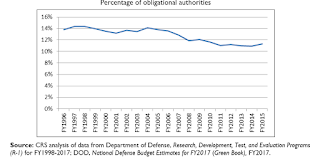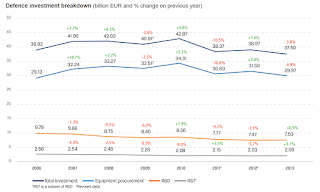WHAT IS MILITARY RESEARCH AND DEVELOPMENT?
The military R&D includes basic research, applied research and demonstrations/validation. The R&D in US DoD is extended with Test and Evaluation (T&E) which means engineering manufacturing development, testing and evaluation of components, systems, and system of systems, and operational system development (RDT&E).For example, US DoD has invested the following in defence related RDT&E functions past 20 years:
Nevertheless the 11-14% annual investment to their RDT&E, the US DoD thinks that they have lost their technical advantage because the sensitive information has been stolen from their defence industry base of knowledge, more advanced civilian technology is used by adversary militaries and the challenges within defence industry of US.
Despite the previous innovations from microchips to GPS systems, the US DoD R&D control is loosening together with privatisation and globalisation. The new global R&D environment diffuses faster different technologies, has lower barriers to entry and provides easier access to scientific information.
European Union includes Research and Technology in Military R&D. They decided late 2016 to start investing in military-oriented research, namely electronics, advanced material, encrypted software, and robotics. European Defence Agency (EDA) has recently established a defence capability development programme trying to improve cooperation between its members. EDA support the science and technology capability areas with strategic research agenda aiming to identify potential technologies, assessing their possibilities in military utilisation and prioritisation of their funding.
European Union’s member states invest in military R&D about 1.4 % of their GDP (avg. 4% of their total defence expenditure ), where US is investing 3.32% and China 1.64% of their GDP. See the trend in EU member’s investments in defence R&D below.
WHY ARMED FORCES DO R&D?
The rational and amount for Armed Force to invest in R&D can be analysed from their defence strategy:- The US defence strategy is to dominate their possible adversaries by technical advantage being a Pathfinder or at least sustain their technical advantage by protective measures. Therefore, they have a significant base of research and development enterprises and defence industry that seek innovations to apply in military missions. Subsequently, they invest 3,32% of their GDP to military-related R&D.
- The defence strategy of EU members is mainly maintaining sufficient forces and build their capabilities more in an evolutionary manner, i.e., in smaller increments supporting their national industrial base. Therefore, the R&D investments in EU are parallel, competing and slowly applied in the defence industry. Subsequently, the EU members average R&D investment is below 1.5% of GDP.
- China is accelerating the evolution of its military force first by claiming asymmetric means of effect and secondly using its manufacturing power to gain the US technical advantage . Furthermore, they use efficiently the technical innovations made in the civilian sector to gain military effect. Subsequently, they use 1.64% of their GDP in military R&D (8-10% of their defence budget).
The strategic analysis is based on Gattorna’s four postures illustrated in the following Figure.
In conclusion, the amount and focus of military-related R&D should be aligned with national or coalition specific military strategy. China has been gradually but steadily increasing theirs to gain more military might over the regional sources of energy and materials. European Union has been reawakening by Russian commercial and regional aspiration and is trying to gain some technical advance over Russian operational dominance in land warfighting. Despite their continuous investments in R&D, US has not been able to battle against the accelerated development of open information technology.
When considering the diverse levels of military RDT&E with some examples of different strategies, the following distribution in R&D emphasis may occur:
|
|
Pathfinder
US
DoD/China
|
Protectionist
US
DoD
|
Evolutionary
EU
|
Operational
Russia
|
|
Basic Research
|
Governmental investment in
foundational sciences. “Race for the Ring of Gyges.”[1]
|
Defending their existing Base of
Knowledge
|
N/A
|
N/A
|
|
Applied Research
|
Boosting national engineering
and technology competencies
|
Investing in critical applications:
information, ISR, autonomous, guidance
|
Trying to improve alignment in
applications development
|
N/A
|
|
Experimenting and Validation
|
Several experimental and
prototype programmes
|
Trying to find civilian
solutions applicable to military
|
Open experimenting and
validation sessions/exercises to all members and industry
|
N/A
|
|
Testing and Evaluation
|
System of Systems integration
|
Spiral development shortening
the DevOps cycle
|
Permanent Test and Evaluation
Environment to provide continuous and integrated improvement
|
Prototyping forces develop the
cull capability (people, process, and technology)
|
|
Manufacturing Development
|
Using both civilian and defence
industry to provide best products
|
Faster, cost-efficient, in-field
|
Normal government support to
their national Defence Industry
|
N/A
|
|
Operational Development
|
Using innovations collected from
field
|
Improving the use of existing
and gradually evolving technology. Protecting their details and parameters
from being captured.
|
Iterative roll-outs to training
of troops
|
Systematic improvement of
operations capabilities through training and lessons in operations
|
In conclusion, the military R&D methods and investments are guided by their strategies:
- Pathfinder establishes as wide as possible R&D in building national level dominance, and the applies it from basic research to operational development as fast as it can.
- Protectionist tries to prevent the adversaries from catching up their technical advantage by securing their bases of knowledge, improving the existing systems gradually and preventing the capture of their military equipment in the field.
- Evolutionary attempts to keep up with normal military development but with minimised investments. They prefer to buy their military systems from pathfinders/protectionists and focus on some niche areas of their national defence industry.
- Operational dominance seeker tries to improve their existing forces equipped with existing armament by training them, developing operational capabilities and improving their performance to fulfil the military missions better.
WHAT ARE THE FOCUS AREAS FOR MILITARY R&D?
The paper is using US DoD categorisation of military Research, Development, Test, and Evaluation (RDT&E) where European Research and Technology is included. The following table provides examples of contemporary focuses of some of the military R&D agencies within these categories.|
|
U.S. DARPA[1]
|
E.U. EDA[2]
|
Sweden FOI[4]
|
|
|
Basic Research
|
Biomedical technology, ICT,
tactical technology, materials, electronics
|
Materials and structures,
Energy, technologies for components and modules
|
|
Security Policy, crisis
preparedness and the safety and security of society
|
|
Applied Research
|
Aerospace systems, space
technology, advanced electronics, C3, NEC, sensors
|
RF sensor technologies,
Electro-optical sensors, CBRN protection, Guidance, and Navigation systems,
CIS and Networks
|
coordination of activities of
scientific organizations and high schools of the Ministry of Defence,
scientific organizations of the Russian Academy of Science, other ministries
and agencies
|
Aeronautics, CBRN, decision
support and information fusion, electronic warfare, sensors, and signatures,
underwater technology
|
|
Experimenting and Validating
|
Small business innovation
research
|
Battle lab, modelling, and
simulation
|
Create modelling and laboratory
and experimental basis
|
Combat simulation, methodological
and investigative support
|
|
Testing and Evaluation
|
|
System of systems, cyber
research
|
scientific complex of the Armed
forces, its composition, structure, and staff size with due regard to its
actual needs
|
Weapons, protection, and
security
|
|
Manufacturing Development
|
|
Aerial systems, ground systems,
Naval systems
|
|
|
|
Operational Development
|
Mission support
|
Ammunition technology
|
study of the other most actual
problems
|
|
[1]
https://www.darpa.mil/attachments/DARPA_FY18_Presidents_Budget_Request.pdf
[2]
https://www.eda.europa.eu/industry-info/research-technology
[3]
http://eng.mil.ru/en/science/sflmrd/about.htm
[4]
https://foi.se/en/our-knowledge.html
Subsequently, the strategic emphasis can be seen in titles and the categories the military focus. The Russian SFLMRD is focusing on fulfilling operational needs and solving actual problems on the battlefield. On the contrary, DARPA is emphasising the basic and applied research with extension to small companies’ innovations.
The Pathfinder DARPA is investing in innovative technologies to gain strategic advantage, whereas the Swedish FOI is focusing on researching force protection, information technology, and security policies as support to evolutionary Defence Forces.






No comments:
Post a Comment